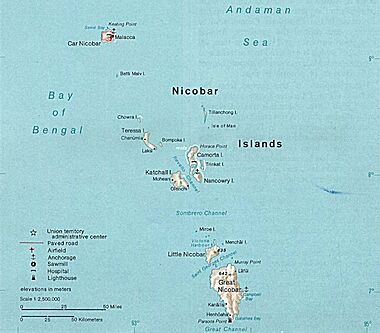Nicobar long-tailed macaque facts for kids
Quick facts for kids Nicobar long-tailed macaque |
|
|---|---|
 |
|
| Nicobar long-tailed macaque in Nicobar Islands, India | |
| Conservation status | |
| Scientific classification |
|
| Kingdom: | Animalia |
| Phylum: | Chordata |
| Class: | Mammalia |
| Order: | Primates |
| Suborder: | Haplorhini |
| Infraorder: | Simiiformes |
| Family: | Cercopithecidae |
| Genus: | Macaca |
| Species: | |
| Subspecies: |
M. f. umbrosa
|
| Trinomial name | |
| Macaca fascicularis umbrosa Miller, 1902
|
|
The Nicobar long-tailed macaque (Macaca fascicularis umbrosa), also known as the Nicobar monkey, is a type of crab-eating macaque. This monkey is special because it lives only on the Nicobar Islands in the Bay of Bengal, India. You can find these primates on three islands: Great Nicobar, Little Nicobar, and Katchal Island. They live in warm, wet forests.
Contents
Appearance and Life Cycle
The Nicobar long-tailed macaque has brownish to grey fur. Its belly is usually lighter in color. Their face is pinkish-brown, and they have white spots on their eyelids.
Baby macaques are born with dark fur. This fur gets lighter as they grow up, usually by the time they are about one year old. A baby macaque stays inside its mother for about five and a half months before it is born.
Adult male macaques are about one and a half times bigger than females. Males can grow up to 64 centimetres (2 ft) tall and weigh up to 8 kilograms (18 lb). Males also have bigger canine teeth than females. Their tail is longer than their body (from head to rump).
Like other macaques, they have special cheek pouches. They can store food in these pouches for a short time. This helps them carry food away from where they found it to a safer place to eat. In zoos, these monkeys can live for about 30 years. In the wild, their lives are usually much shorter.
Where They Live

A study in 2003 found about 788 groups of these macaques in the wild. Each group had about 36 monkeys on average, but some groups had as many as 56. These groups include several adult males and females, along with their young. There are usually about four adult females for every adult male. The number of young monkeys is similar to the number of adult females, which means the population is healthy and growing.
Besides the wild populations, only one group of about 17 Nicobar macaques lives in an Indian zoo. They are there for breeding and research.
Many of these macaques live in the Great Nicobar Biosphere Reserve. This area includes two National parks of India: Campbell Bay National Park and Galathea National Park. These areas are protected by law. However, more people are building homes and farms near the forests. This can cause problems. Sometimes, groups of macaques go into farms and damage crops. A few monkeys have been trapped or moved to protect coconut farms.
The Shompen people, who are native to Great Nicobar, have traditionally hunted these macaques for food. However, monkeys are not a big part of their diet.
Their Home Environment
The Nicobar long-tailed macaque likes to live in mangrove forests, other forests along the coast, and areas near rivers. They can also be found in forests further inland, up to 600 metres (2,000 ft) high. The highest point in the Nicobar Islands, Mount Thullier, is about 642 metres (2,106 ft) high. They especially like areas with Pandanus trees.
Macaques living near the coast spend more time on the ground. Those living inland in the forests spend more time in the trees. Each group has a favorite area, usually near water, where they roam. This area is about 1.25 square kilometres (310 acres) on average.
Daily Life and Habits
The Nicobar long-tailed macaque mainly eats fruits and nuts. When their favorite fruits are not available, especially during dry or early rainy seasons, they eat other things. This can include young leaves, insects, flowers, seeds, and tree bark. They also eat small crabs, frogs, and other creatures they find along the shorelines and in mangroves.
If they live near human homes and farms, they often visit these areas to find food. They might even go into houses if people don't scare them away.
Like all primates, they are social animals. They spend a lot of time together, playing and grooming each other. They usually look for food in the morning. During the middle of the day, they rest in groups. Then, they look for food again in the early evening. At night, they return to special trees to sleep.
They walk on all four limbs, both on the ground and in trees. They can jump up to 5 metres (16 ft) from one tree to another. Like other long-tailed macaques, they are also good swimmers. They might swim to escape from predators that try to catch them on the ground or in trees.
Conservation Status
The IUCN Red List says the Nicobar long-tailed macaque is a vulnerable animal. This means they are at risk of becoming endangered. This status was changed in 2004 after more studies. It shows that human activities are causing more problems for their homes, especially on Katchal Island. However, the Wildlife Institute of India said in 2002 that they were critically endangered. This shows how worried people are about protecting these monkeys.


